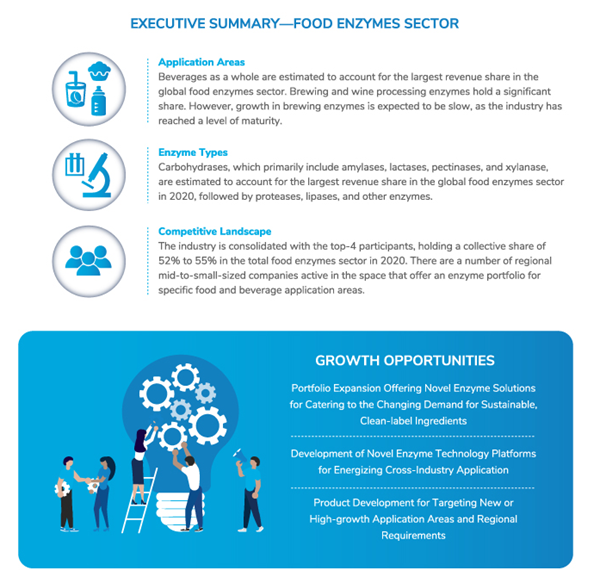New Product Innovations to Cater to the Demand for Clean-label Products Will Fuel Innovation in Food Enzymes
Enzymes are defined as specialized proteins that act as catalysts to speed up a specific reaction. In most cases, enzymes used in food are used as processing aids, where they aid in the manufacturing of food or food ingredients but do not have a function in the final product. Very few enzymes are used as food additives or ingredients and are functional in the final product.
The demand for ‘free-from', healthy, and clean-label food products is a key factor driving growth across food enzymes. Health-conscious consumers are driving dairy and bakery product formulators to rethink their label claim strategies. The need for better-for-you products globally is expected to drive the adoption of enzymes compared to chemical or synthetic processing aids. The other trend that is prevalent across the bakery and brewing industry is the use of local and ancient grains for the production of artisanal or craft products. The increase in the popularity of ancient and local grains is expected to offer an opportunity for enzyme technologies, as working with ancient grains could pose formulation challenges in terms of texture, softness, and freshness. Alternative plant-based products are expected to drive the demand for novel enzyme solutions that can help formulators to improve the texture and flavor profile of plant proteins while catering to clean-label requirements.
The focus of the present research is to assess the opportunity across food and beverage enzymes being used as processing aids. The key enzyme categories considered are carbohydrases, lipases, proteases, and other enzymes, such as transferases and oxidoreductases. The carbohydrases category, which primarily includes amylolytic enzymes, lactases, pectinases, and xylanases, is estimated to account for the largest share in the total food enzymes market in 2020. Carbohydrases are used across all major application areas, such as bakery, brewing, dairy, and starch processing. Overall, beverages accounted for a majority of the share in 2020, followed by bakery and enzymes used in other application areas, including starch, meat and seafood, and fat and oil processing. The demand for fresh, environment-friendly, and clean-label products will drive the adoption of enzymes as processing aids. Across the bakery sector, the trend of reducing food wastage is another key driver for enzymes, as enzymes can help manufacturers produce high-quality products with improved longevity and flexibility. Historically, enzymes were derived from animal sources; however, in the last several decades, microbial sources have gained prominence. In 2020, microbe-derived enzymes were estimated to account for the largest share, followed by plant-derived enzymes that are estimated to register higher growth during the forecast period, as the industry looks for more stable enzyme alternatives.
In terms of regions, Europe held the largest share in the food enzymes market in 2020, closely followed by North America. Higher adoption of enzyme technologies across different end-applications, both in Europe and North America, are the key factors driving higher market share. Asia-Pacific (APAC) and Latin America, the Middle East, and Africa (LAMEA), on the other hand, are estimated to account for higher growth, driven by higher penetration. Formulators in the region are switching to enzymes to cater to the growing consumer demand for clean-label products. Across APAC, growth is expected from markets such as China, Japan, India, and some Southeast Asian countries.
In terms of the competitive environment, the food enzymes market is highly consolidated with the top-4 global participants holding a majority of the share. Though there are a number of mid-to-small-sized regional participants specializing in specific application areas, most innovations are being driven by large multinationals such as Novozymes, IFF, and AB Enzymes. Companies are mainly focused on organic growth strategies, with innovation and expansion of product portfolio being the key growth approach. However, there lies a significant opportunity for them to collaborate and partner to develop novel enzyme solutions. There is also an opportunity in developing enzyme technologies that can target high-growth application areas (e.g., developing enzymatic solutions for the plant-based dairy or meat industry).
Growth Opportunities
Table of Contents
Companies Mentioned (Partial List)
A selection of companies mentioned in this report includes, but is not limited to:
- AB Enzymes
- IFF
- Novozymes









